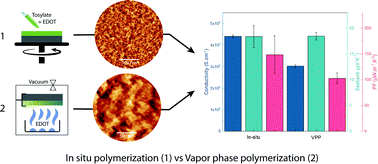PEDOT:Tos electronic and thermoelectric properties: lessons from two polymerization processes†
Abstract
In the landscape of π-conjugated polymers, poly(3,4-ethylenedioxythiophene) doped with iron(III) p-toluenesulfonate (PEDOT:Tos) has shown promise as a thermoelectric material for near room temperature applications. Such properties are inherent to its semi-metallic nature when optimally doped leading to high electrical conductivity and a relatively good Seebeck coefficient. Nevertheless, the final thermoelectric properties of PEDOT:Tos are highly influenced by the polymerization pathways and a thorough understanding of the interplay between polymerization processes and thermoelectric properties is needed. Here, PEDOT:Tos thin films with a doping level of 22 ± 2% were produced by in situ polymerization and vapor-phase polymerization and a comparative study was performed in order to investigate the subtle correlations between morphological features and electronic signatures for both types of samples. Accordingly, optimized in situ polymerized PEDOT:Tos films were demonstrated to exhibit higher electrical conductivities (up to 4398 ± 68 S cm−1) and power factors (up to 148 ± 37 μW m−1 K−2), highlighting the importance of the polymerization process on the final thermoelectric properties.



 Please wait while we load your content...
Please wait while we load your content...